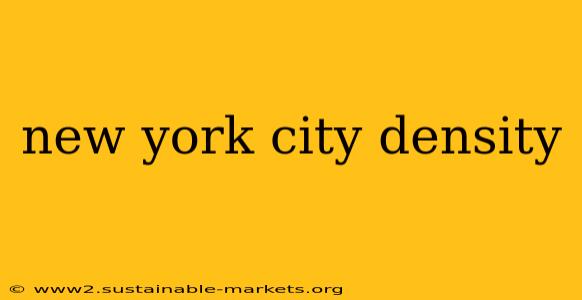New York City. The name conjures images of towering skyscrapers, bustling streets, and a relentless energy that's unmatched anywhere else in the world. But beyond the iconic imagery lies a fascinating reality: an unparalleled population density that shapes the city's character, its challenges, and its unique appeal. This post will delve into the intricacies of NYC's density, exploring its causes, consequences, and what makes it such a compelling urban phenomenon.
Understanding NYC's Population Density: More Than Just Numbers
When we talk about New York City's density, we're not just talking about a high number of people crammed into a small space. It's a multifaceted concept encompassing several key factors:
-
Population Density: This is the most straightforward measure – the number of people per unit area (usually square mile or kilometer). NYC's overall population density is incredibly high, significantly exceeding that of most other major global cities. However, it's crucial to understand that this density varies dramatically across different boroughs and neighborhoods. Manhattan, for example, boasts a far higher density than Staten Island.
-
Housing Density: This refers to the number of housing units per unit area. High-rise buildings and densely packed brownstones contribute significantly to NYC's high housing density, directly impacting population density.
-
Job Density: The concentration of jobs within a specific area is another critical aspect. NYC's high job density, particularly in Manhattan's financial district and Midtown, further contributes to its overall population density during working hours.
-
Building Density: The sheer number of buildings, their height, and their proximity to one another directly influence population density. The verticality of Manhattan's skyline is a testament to this.
The Factors Contributing to NYC's Dense Population
Several historical and logistical factors have contributed to NYC's exceptional density:
-
Geographic Constraints: The island of Manhattan, with its limited land area, naturally forces high population density. This geographical constraint has historically shaped the city's development patterns.
-
Excellent Public Transportation: NYC's extensive subway system and bus network allow for efficient movement of large populations, accommodating high density without causing crippling congestion.
-
Economic Opportunities: The city's position as a global economic hub attracts a massive influx of people seeking employment and opportunities. This continuous influx sustains and enhances the high population density.
-
Cultural and Social Attractions: NYC’s vibrant cultural scene, diverse population, and countless entertainment options contribute to its appeal as a place to live and work, fueling its already high population density.
The Implications of High Density: Challenges and Opportunities
Living in a high-density environment presents both challenges and advantages:
Challenges:
-
High Cost of Living: Limited space and high demand drive up the cost of housing and other essential goods and services.
-
Infrastructure Strain: The high population puts a strain on infrastructure, including transportation, sanitation, and utilities.
-
Competition for Resources: Competition for limited resources like schools, parks, and healthcare services can be intense.
-
Environmental Concerns: High density can contribute to increased pollution and other environmental challenges.
Opportunities:
-
Economic Dynamism: High density fosters innovation, collaboration, and economic growth.
-
Cultural Richness: A diverse population contributes to a vibrant cultural landscape with endless entertainment and dining options.
-
Efficient Resource Use: High-density living can lead to more efficient use of resources like energy and water.
-
Reduced Carbon Footprint (Potentially): With efficient public transportation, a high-density city can potentially have a lower carbon footprint per capita than sprawling suburban areas.
Conclusion: Navigating the Urban Jungle
New York City's density is a defining feature, a complex interplay of geographic constraints, economic opportunities, and social factors. While it presents significant challenges, it also fuels the city's extraordinary dynamism and unique character. Understanding this density is key to grasping the city's past, present, and future – and appreciating the intricate tapestry of life within the urban jungle.

